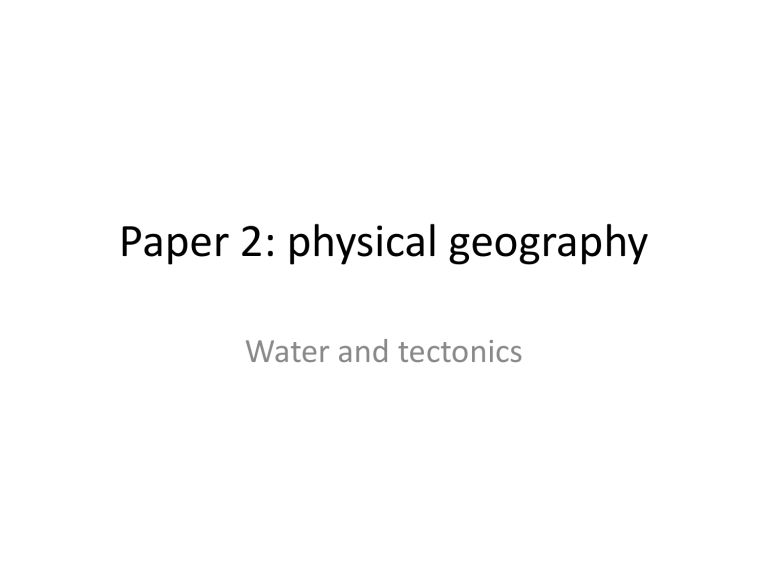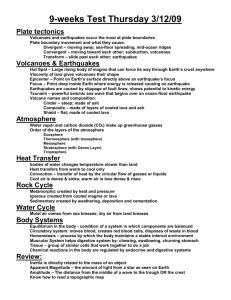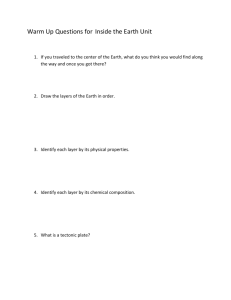Paper 2: physical geography

Paper 2: physical geography
Water and tectonics
‘Showering societies’
• High standards of living lead to the choice for water.
• This leads to the perception that a high standard of hygiene is important- people shower in the morning and then later in the day.
• This uses large volumes of water.
Name 3 ways water is supplied in the local area……….
Water surplus and deficit
• This depends on the relationship between the water it receives through rainfall and what it looses through evapotranspiration.
• Evaporation can be cause by high temperatures- some places can loose more than they are supplied.
• Some places in Africa near the equator have high rainfall but they are hot so loose a lot from evaporation so do not have a surplus.
• You need to be able to describe and explain this pattern
How is water supplied????? What would have an impact on this supply?
What is the distribution of population?
Water supply problems in LICS
• Quality
• Spatial variation
• Seasonal variability
• Loss through broken pipes
Most likely: seasonal variability
Costa del Sol, Spain. In July and August the average rainfall is nil, whereas in months such as November there are
90mm. In the summer months the demand for water is greatest as it is a tourist area. Swimming pools need to be supplied by water and golf course need watering (there are over 70). This is in conflict for the normal domestic use and for agriculture.
Water supply problems in LICs
• Lack of available clean water
• Water borne disease
• Water pollution
You need to explain what problems these cause and why
What is the problem, what causes this problem what problems does this problem cause
Appropriate technology
• Know the definition
• Explain how Low Income Countries (LICs) use appropriate technology to provide water for small communities. (4)
Have 2 examples
Explain what they do and why they are appropriate
• Play pumps (borehole)
• Water recycling (India)
• Hand dug wells
6 mark questions….
• Choose a water management scheme you have studied.
Explain the effects of the scheme.
• Choose an example of a water management scheme you have studied. Explain the reasons for the scheme.
• Choose a water transfer scheme you have studied. Explain how the water transfer scheme has caused conflicts between areas.
• Choose a case study of water transfer which has caused conflicts between two or more areas. Explain how water transfer can cause conflicts.
Using the same mark scheme what 6 mark detail should be included for a
Colorado River Basin 6 mark question?
BUT…..be prepared for other 6 mark questions!!!!
Tectonics
Plate boundaries: learn them!!!!
Use geographical description language
Name places
(a) Earthquakes occur in broad belts. Tend to be found in the middle of oceans e.g. Atlantic or along the edges of continents e.g. West coast of
North America. Can also occur just off-shore of continental landmasses, e.g. western Pacific Ocean. There are some exceptions; there are earthquakes inland such as in eastern Africa.
Say the general pattern
Exceptions to the rule
(b) Volcanoes also occur in broad belts. Found along the edges of continents e.g. West coast of South America. Can be found just off-shore of continental landmasses, e.g. western Pacific Ocean. Anomalies include cluster of volcanoes in the mid-Pacific around Hawaii and band of volcanoes inland in eastern Africa.
Landform formation questions
• You need to be able to explain this for both convergent and divergent boundaries
Explain the processes that take place at divergent plate boundaries
(4)
Explain the processes that take place at divergent plate boundaries (4)
Divergent plate boundaries are when two plates move away from each other. The plates move due to convection currents in the mantle. The movement can cause a gap called a mid-oceanic ridge. Magma rises to fill the gap, thus creating new land. Where magma builds up above the surface of the ocean, volcanic islands form. If a constructive
(divergent) margin is found on the land a rift valley will be formed.
What happens at a conservative plate boundary?
• Plates slide past each other. No volcanoes or new landforms are created occur because no magma rises and no crust is being destroyed.
• Stresses build up in the rocks. When the pressure is released the result is a violent earthquake. An example is the San Andrea Fault in North America. At the San-
Andreas fault both plates are moving north-west but at different speeds. Instead of slipping smoothly past each other they tend to ‘stick’. The pressure builds up until suddenly the plates jerk forwards sending shock waves to the surface triggering a sudden earthquake.
Hotspots
• Not on plate boundaries
• Hot Magma erupts through the crust
• This creates volcanoes that often rise above the ocean surface to create islands.
• The Hawaiian islands chain formed as the
Pacific crustal plate moved over a stationary source of magma or hotspot
Mark scheme
Example of what another student wrote and how the examiner marked them!
Key terms you must know…..
• Mercalli scale
• Richter scale
• Focus
• Epicentre
Why do people live in tectonic areas.
Volcanic
• The weathered volcanic rock creates fertile soil
• Tourist opportunities- from volcano, which adds to attractive scenery
• Montserrat Volcano observatory- there will be a lot of warning before the volcano- evacuation can happen
• Volcanic hazards can be reduced- by diverting lava flow, spraying lava to cool it down
• People may be ignorant of the risks
• People may be too poor to move
• Geothermal energy- all of the street lights in Reykjavik, Iceland are powered by this source
Earthquakes
• Earthquake proof buildings (e.g. Trans-
America Pyramid). Counter-weights, base isolators etc….
• Land use planning
• Preparation of the population- quake cottage, earthquake drills in school, emergency kit, koso value
• Well prepared and equipped emergency services
• Very good economic base in the area….
Apple, Microsoft etc in the Silicon Valley
• Attractive coastal scenery (Half Moon Bay) good for surfing, very good climate (30 degrees in summer 10 degrees in winter and low rainfall 300-400 mm per year). Good tourist economy
• Big earthquakes happen very infrequentlythe benefits outweigh the risk
• 2012: Suggest reasons why people continue to live in areas affected by earthquakes.(4)
• 2010: Suggest reasons why people continue to live in areas affected by volcanic eruptions. (4)
The 6 mark questions
• For an area prone to earthquakes that you have studied explain why people choose to live there (6)
• Explain the methods used both before and after a natural disaster to limit its
• effects.(6)
• 2011: Choose a volcanic eruption or an earthquake you have studied. Explain the causes of the volcanic eruption or earthquake.
(6)
• 2010 Choose a volcanic eruption or an earthquake you have studied. Explain the effects of the volcanic eruption or the earthquake on the people and the environment. (6)
• 2012: Explain how the effects of volcanic eruptions are reduced through prediction and prevention. Use examples in your answer.
(6)
Cause of the eruption…
• Destructive plate boundary (convergent)
• North American Plate is being forced
( subducted ) under the Caribbean plate
• Convection currents pull the plate into the mantle causing the rock to melt.
• The molten rock is lighter than the surrounding rock which causes it to rise through the cracks towards the earths surface
Cause of the eruption
• The volcanic eruption was so deadly because the volcano produced sticky andesitic lava
(thick lava).
• The lava is so thick it created a dome on the side of the Chances Peak volcano .
• As the dome collapsed a huge ash cloud was formed.
• Also the dome collapse caused hot rocks, gases and ash- a pyroclastic flow.
Exam question- January 2011
Monitoring of the volcano from the
MVO
Exam question June 2011
The effects of the 1989 earthquake included:
- 67 Deaths
- 6,000 Homes damaged / destroyed
- 2000 people made homeless
- Upper deck of the Nemitz highway collapsing onto the lower deck crushing people in their cars
- A section of the San Francisco-Oakland Bay Bridge collapsing
- Fire resulting from gas explosions
- Massive economic costs ($4.4 billion)
- Damage to infrastructure - electricity / gas and water mains cut
3 Areas in San Francisco were particularly badly affected:
1. The Marina / Bay District
Here the buildings were wooden and not securely attached to their foundations. The area was also located on an old landfill site, which was created following the devastation caused by the 1906 earthquake. Liquefaction occured. This is where as the ground acted more like a liquid as water moved up through the sediments resulting in reduced strength and causing buildings to collapse due to lack of support.
Liquefaction
• A condition where soil flows like a liquid. This caused extensive damage in the area including the collapsed overpasses and freeways.
2. Collapse of the Double-Decker
Nimitz Highway and San Francisco-
Oakland Bay Bridge
A number of roadways were damaged during the earthquake, including the collapse of the upper tier of the double-decker Nimitz Highway
(Interstate 80) onto the lower deck, killing and trapping motorists in their cars. The collapse was caused partly by soil failure and also the unsuitable design of the supporting piers. A section of the Bay Bridge also collapsed killing motorists.








